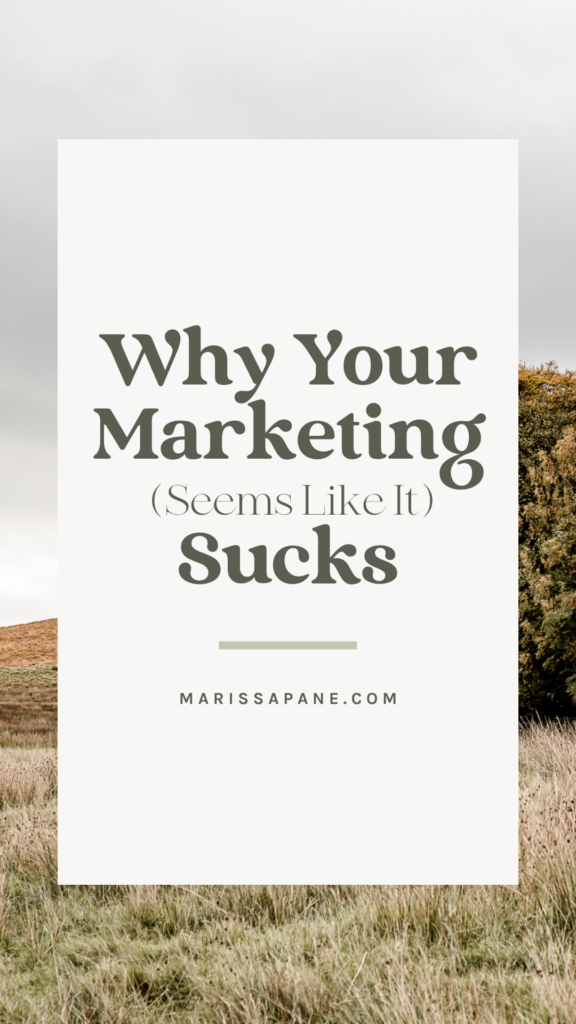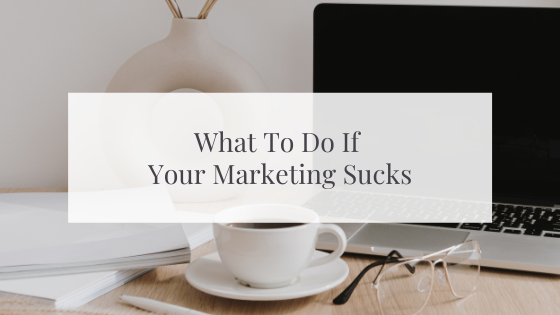If your marketing isn’t converting, chances are you’re having thoughts like: “My digital marketing strategy doesn’t work. Marketing is a waste of money. I feel like digital marketing is one big bamboozle.” As a digital marketing coach, I constantly hear clients say their marketing basically sucks. If you feel your marketing efforts aren’t working either… keep reading so we can improve your digital marketing together.
In simplest terms, if you feel like your marketing sucks right now, the reason why is that digital marketing allows you to reach billions of people online. That is the lore of why so many people love digital marketing and the possibilities that it opens for you and your business.
But here’s the catch, unless you hyper-focus your content specifically to help your ICA, the content you create will undoubtedly get lost in the shuffle. Think of how many blog posts, podcasts, or social media posts are published each and every day. There is a lot of content online. Not all of it may be good content, but there is an excess of content to sort through as a consumer.
If you are not hyper-focused and specifically targeting your ideal customer in everything that you do, your content will never be found by the people who need it most.
The online space allows you to reach billions of people all over the world, but when you’re not zeroing in on who you really want to reach, having access to billions of eyeballs will be as effective as throwing spaghetti on the wall.
Step one of making sure your digital marketing is working in your favor:
Ensure that your content is reaching your ideal people and it’s not just getting lost in the shuffle.
To help clarify what I mean, think of this in terms of being a designer. As a designer, you have so many different opportunities available for you to niche down and to specify in. For example, as a designer, if you’re saying, “Hey, here are 10 design tips to make your next piece of content amazing!” – It’s time to specify, are you teaching them how to use Canva? Are you teaching them how to use Photoshop, Illustrator, InDesign? What aspect are you teaching them? Who is this for?
Instead of publishing a very generic headline like what was previously mentioned, you can say something more along the lines of, “Five tips to use Canva to design your small business’ new brochure.”
In this example, the topic is hyper-focused on who you are targeting and why they should click that blog post or that podcast episode as opposed to your competitors or all of the other things that might end up on their Google search.
The other thing you can think about this is in regards to YouTube content. Have you ever went onto YouTube specifically to find out how to do something? While you’re typing things in, you’re trying to figure out the best way to put it because you’re not entirely sure, and all these videos pop up that say they’re going to help you or they sound like they could help you, but you know it’s only one segmented piece of that video that’s really going to help you and now you’re scrubbing through the video, scrolling through trying to find where the actual content you want is?
When you create shorter content or more specific, hyper-focused content, you’re able to reach those people immediately and come to the top of their feed and everything else.
For example, the other day, I was looking for a tutorial on how to create a specific style of text. I went over to YouTube, typed in exactly what I was looking for, and, bingo, lo and behold, the exact video and the exact instructions I needed appeared at the top of the feed.
Now, if on my search, the creator hadn’t labeled his YouTube video as exactly what I needed, I wouldn’t have been drawn in to watch it. If instead, he just said, “Cool fonts that you can do for effects like vintage effects,” that would not have caught my attention or gotten me to invest my time into his content.
However, the fact that his video was titled something along the lines of, “How to get movie subtitle text on your images,” I knew this was exactly what I needed and I dove right in.
Friendly reminder to always think of headlines or standout copy in terms of what people are searching for when they are on Google, on YouTube, and cater to those people.
I honestly feel that shorter content and more concise content is more beneficial because it’s quick, it’s easy to adjust, and you usually don’t have people’s attention for that long. People usually aren’t here to listen to an hour-long episode, or they aren’t here to read a novel of a blog post. They’re here to get the information, run with it, take it, utilize it, and move on.
In summary, when you are hyper-focused on who your content is serving, you’re able to specify that in your headline or your subtitle so it’s easy for people to know that this is the correct piece of content for them.
Step two: Determine your monthly and quarterly business objectives. Then decide how your content can help you reach your desired results.
If you’re just like, “Oh, this is a good idea. Let me post something about it.” or “Oh, this is a good idea. Let me post about it,” and there’s no rhyme or reason, there’s no strategy behind what you’re posting, what you’re creating, and when you’re publishing it – chances are it’s going to be a little lackluster.
You need to figure out, what the purpose is for each piece of content.
Yes, you can be educating your audience, Yes, you could be showing your expertise. But why that piece of content right now? Think about the bigger picture.
If you are about to launch a course or you are about to have some type of sale or new product or something to that effect, maybe educate about your processes of creating that product or maybe educate about why someone would need that product.
Maybe target in on how they are struggling right now and then how your product is going to be the solution. Don’t repeatedly say your product is going to be the solution. Just get their attention and bring it top of mind so that way, when you do announce your product and you’re like, “Hey, have you been feeling XYZ?” Well, this product will alleviate those problems for you and it will solve all the things.
Determining your monthly and quarterly business objectives will give you a better overhead look at where your business is going over the next month, the next quarter, and how you can use your content to reach those goals. Whether it’s financial goals or something else, just know that your content can dictate and can help you get there.

Step three: Plan how you’re going to integrate your content ideas into your content calendar.
This step ties into step two and looking ahead instead of just posting all willy-nilly.
Essentially, if you’re like, “Hey, this is a really great idea. I know this piece of content is going to be absorbed by multiple people and it’s very important for them to actually comprehend and digest,” take that same piece of content, and repurpose it as a YouTube video. Then publish it as a podcast episode, a blog post, a social media post. You can even change the format of the social media post and post it again!
Figure out how it’s going to integrate into your content calendar so you can make the most of what you do create. Then I want you to think about, if you’re more focused on your direct response marketing, which is when you’re focused on getting an immediate, tangible return, whether that is someone sees your piece of content and then they sign up, they opt-in for your lead magnet, they buy a low ticket product or whatever your like action is? Or are you in the process of creating content that is just raising brand awareness? And this is when you’re building trust and authority.
Whatever your desired result is, you have to keep that in mind when you’re publishing your content. Without a clear objective with each piece of content, you’re going to think that your content is failing.
For example, if you publish a brand awareness piece of content and you’re like, “Well, it didn’t make any sales.” That’s probably because you didn’t have a CTA. That wasn’t the goal of that piece of content.
By not properly aligning your mindset with the type of content you’re publishing, you’re always going to feel like you’re failing or that nothing is happening. Nothing seems to be moving forward, because you’re not paying attention to the purpose of each piece of content that you post and its overall goal.
Keep these three tips in mind and if after following my direction, you still feel like your marketing sucks, we can have a personalized chat on how to better align your marketing efforts.

